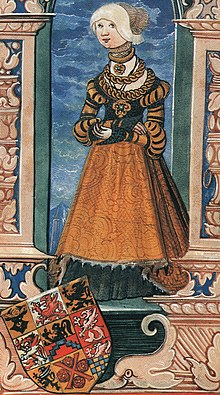Sophie of Pomerania
Sophie, Princess of Pomerania († April 26, 1504 ), Duchess of Mecklenburg from 1478 to 1504.
She was the daughter of Duke Erich II (Pomerania) († 1474) and his wife Sophia († 1497). Her brother was Bogislaw X. (1454-1523), who ruled the country as a unified territory for almost fifty years. Pomerania experienced a heyday under Bogislaw X. Stettin was made a residence in 1491, a ducal administration with a chancellery was created, an orderly tax collection was introduced and the peace of the land was observed. For political reasons, the Duchy of Mecklenburg wanted a connection with the Pomeranian house.
Sophie von Pommern was the fiancée of Johann VI. , the brother of her future husband Magnus II of Mecklenburg . After Johann's death, Sophie entered a monastery and thus swore the vow of eternal chastity. But Magnus II was very interested in securing the border with Pomerania and therefore in marrying Sophie. He asked several clergymen for advice on how to cancel the vow in vain. So he married Sophie on May 29, 1478 against church laws. But instead of being condemned, he received in 1487 from the "Pope the golden virtue rose, the highest ecclesiastical honor". On April 3, 1486, Sophie finally received a dispensation from her vow , which was, however, linked to the condition that three arms should be provided with white woolen clothes in memory of the Virgin Mary every year.
The place of death of Sophie is not known. Like her daughter, who would later become Landgravine Anna von Hessen , over two decades later, Sophie also went her own way with regard to her burial site. After all her Mecklenburg relatives including her husband had themselves buried in the Doberaner Minster , she chose the Dominican monastery in Wismar as her last resting place. Sophie's funeral was the first of the ducal house in Wismar and - apart from her sister Margarete, Balthasar's widow , on March 27, 1526 - also the last.
The bronze grave slab with the life-size image of the duchess resting on a pomegranate ceiling initially covered her crypt on the main altar of the church of the Dominican monastery until 1880, then came to the Marienkirche and has been in one of the north side chapels of the Nikolaikirche since its destruction .
literature
- Friedrich Schlie : The art and history monuments of the Grand Duchy of Mecklenburg-Schwerin. Volume II: The district court districts of Wismar, Grevesmühlen, Rehna, Gadebusch and Schwerin. Schwerin 1898, reprint Schwerin 1992, p. 54ff. (to the grave plate with ill.) ISBN 3-910179-06-1
Web links
| personal data | |
|---|---|
| SURNAME | Sophie |
| ALTERNATIVE NAMES | Sophie of Pomerania (wrong name form) |
| BRIEF DESCRIPTION | Princess of Pomerania; Duchess of Mecklenburg |
| DATE OF BIRTH | 15th century |
| DATE OF DEATH | April 26, 1504 |

